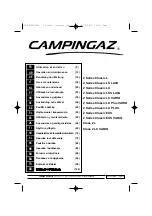
5
ENGLISH
(Original instructions)
energising power tools that have the switch on invites
accidents.
d. Remove any adjusting key or wrench before turning
the power tool on.
A wrench or a key left attached to a
rotating part of the power tool may result in personal injury.
e. Do not overreach. Keep proper footing and balance at
all times.
This enables better control of the power tool in
unexpected situations.
f. Dress properly. Do not wear loose clothing or
jewellery. Keep your hair and clothing away from
moving parts.
Loose clothes, jewellery or long hair can
be caught in moving parts.
g. If devices are provided for the connection of dust
extraction and collection facilities, ensure these are
connected and properly used.
Use of dust collection can
reduce dust-related hazards.
h. Do not let familiarity gained from frequent use of
tools allow you to become complacent and ignore
tool safety principles.
A careless action can cause
severe injury within a fraction of a second.
4. Power tool use and care
a. Do not force the power tool. Use the correct power
tool for your application.
The correct power tool will do
the job better and safer at the rate for which it was
designed.
b. Do not use the power tool if the switch does not turn it
on and off.
Any power tool that cannot be controlled with
the switch is dangerous and must be repaired.
c. Disconnect the plug from the power source and/or
remove the battery pack, if detachable, from the
power tool before making any adjustments, changing
accessories, or storing power tools.
Such preventive
safety measures reduce the risk of starting the power tool
accidentally.
d. Store idle power tools out of the reach of children and
do not allow persons unfamiliar with the power tool or
these instructions to operate the power tool.
Power
tools are dangerous in the hands of untrained users.
e. Maintain power tools and accessories. Check for
misalignment or binding of moving parts, breakage of
parts and any other condition that may affect the
power tools operation. If damaged, have the power
tool repaired before use.
Many accidents are caused by
poorly maintained power tools.
f. Keep cutting tools sharp and clean.
Properly
maintained cutting tools with sharp cutting edges are less
likely to bind and are easier to control.
g. Use the power tool, accessories and tool bits etc. in
accordance with these instructions, taking into account
the working conditions and the work to be performed.
Use of the power tool for operations different from those
intended could result in a hazardous situation.
h. Keep handles and grasping surfaces dry, clean and
free from oil and grease. Slippery handles and
grasping surfaces do not allow for safe handling and
control of the tool in unexpected situations.
5. Service
a. Have your power tool serviced by a qualified repair
person using only identical replacement parts.
This will
ensure that the safety of the power tool is maintained.
Hammer safety warnings
@
WARNING!
Safety instructions for all operations.
u
Wear ear protectors.
Exposure to noise can cause
hearing loss.
u
Use auxiliary handles, if supplied with the tool.
Loss of
control can cause personal injury.
u
Brace the tool properly before use.
This tool produces
a high output torque and without properly bracing the tool
during operation, loss of control may occur resulting
in personal injury.
u
Hold the power tool by insulated gripping surfaces,
when performing an operation where the cutting
accessory and fasteners may contact hidden wiring or
its own cord.
Cutting accessory contacting a "live" wire
may make exposed metal parts of the power tool "live"
and could give the operator an electric shock.
Safety instructions when using long drill bits with
rotary hammers
u
Always start drilling at low speed and with the bit tip
in contact with the workpiece.
At higher speeds, the bit
is likely to bend if allowed to rotate freely without
contacting the workpiece, resulting in personal injury.
u
Apply pressure only in direct line with the bit and do
not apply excessive pressure.
Bits can bend causing
breakage or loss of control, resulting in personal injury.
u
Never use a chisel accessory in rotary mode.
The
accessory will bind in the material and rotate the drill.
u
Use clamps or another practical way to secure and
support the workpiece to a stable platform.
Holding the work by hand or against your body leaves it
unstable and may lead to loss of control.
u
Before drilling into walls, floors or ceilings, check for the
location of wiring and pipes.
u
Avoid touching the tip of a drill bit just after drilling, as it
may be hot.
u
The intended use is described in this instruction manual.
The use of any accessory or attachment or performance
of any operation with this tool other than those
recommended in this instruction manual may present a
risk of personal injury and/or damage to property.






































